David Suzuki's Blog, page 46
January 14, 2016
We are the world; we must act on that understanding
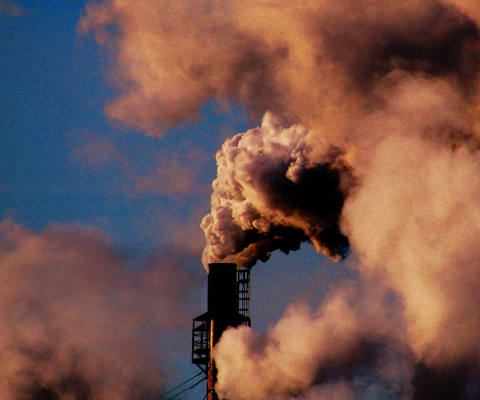
(Credit: Billy Wilson via Flickr)
The coming year looks bright with the promise of change after a difficult decade for environmentalists and our issues. But even with a new government that quickly moved to gender equity in cabinet, expanded the Ministry of the Environment to include climate change, and offered a bravura performance at the climate talks in Paris, can Canada's environmentalists close up shop and stop worrying?
Of course not. The nature of politics includes constant trade-offs, compromises and disagreements. Even with a government sympathetic to environmental issues, we won't act deeply and quickly enough or prevent new problems because we haven't addressed the root of our environmental devastation. The ultimate cause isn't economic, technological, scientific or even social. It's psychological. We see and interact with the world through perceptual lenses, shaped from the moment of conception. Our notions of gender, ethnicity, religion, socio-economic status and the environment we grow up in all limit and create our priorities.
If we were to examine the anatomy of human brains, the circuitry and chemistry of neurons or the structure of our sense organs, nothing would permit us to distinguish gender, ethnicity or religion because we all belong to a single species. But if you were to ask a man and a woman about love, sex or family, answers could be quite disparate. A Jew and Muslim living in Israel might respond differently to questions about Gaza, the West Bank or Jerusalem. A Catholic and Protestant living in Northern Ireland might hold radically different outlooks about their country's history.
We learn how to see the world. That, in turn, determines our priorities and actions. The world has been overwhelmed by the belief that our species stands at the pinnacle of evolution, endowed with impressive intelligence and able to exploit our surroundings as we see fit. We feel fundamentally disconnected from nature and therefore not responsible for the ecological consequences of our actions. Even at the 2015 Paris climate conference, the sense of urgency about climate change was dampened by the perceived equal need to protect jobs and to consider the economic costs of aiding vulnerable nations and even ways to continue exploiting fossil fuels, the very agents of the crisis.
We can't just look at the world as a source of resources to exploit with little or no regard for the consequences. When many indigenous people refer to the planet as "Mother Earth", they are not speaking romantically, poetically or metaphorically. They mean it literally. We are of the Earth, every cell in our bodies formed by molecules derived from plants and animals, inflated by water, energized by sunlight captured through photosynthesis and ignited by atmospheric oxygen.
Years ago, I visited a village perched on the side of an Andean mountain in Peru. People there are taught from childhood that the mountain is an apu, a god, and that as long as that apu casts its shadow on the village, it will determine the destiny of its inhabitants. Compare the way those people will treat that mountain with the way someone in Trail, B.C., will after being told for years the surrounding mountains are rich in gold and silver.
Is a forest a sacred grove or merely lumber and pulp? Are rivers the veins of the land or sources of power and irrigation? Is soil a community of organisms or simply dirt? Is another species our biological relative or a resource? Is our house a home or just real estate?
Once we learn that our very being, essence, health and happiness depend on Mother Earth, we have no choice but to radically shift the way we treat her. When we spew our toxic wastes and pesticides into the air, water and soil, we poison our mother and ourselves. When we frack our wells, we contaminate the air and water on which we depend. When we clear-cut forests, dump mine tailings into rivers and lakes and convert wilderness into farms or suburbs, we undermine the ability of the biosphere to provide the necessities of life.
Is this how we treat our source of survival? Until all of society understands this and then acts on that understanding, we will not be able to act fully to protect a future for ourselves.
Hey! Want more DSF? Join David Suzuki on Facebook

January 13, 2016
What can Canada learn from Germany's energy transition?
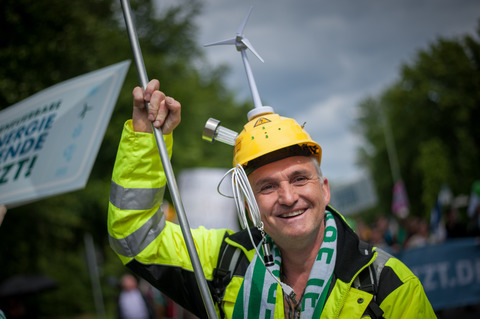
(Credit: campact via Flickr)
"Did I hear correctly?"
Sitting in the office of Agora Energiewende, a Berlin-based energy think tank, I thought I heard its director, Patrick Graichen, say that from 1990 to 2014 Germany's GDP expanded by about 40 per cent while its greenhouse gas emissions dropped 26 per cent.
"Yes, that is correct."
Graichen didn't seem especially impressed. He said from 1990 to 2000 the country enjoyed a "windfall" emissions drop simply by closing outdated and dirty East German factories. But I was astonished. One of the world's great industrial powers grew its economy while reducing carbon output.
How has Germany done it?
During my recent study tour with academics, lawmakers and researchers in Berlin and Dusseldorf, I learned one big piece is the country's robust renewable energy rollout. Camilla Bausch, director of the Ecologic Institute, said a few years back naysayers predicted renewables would have difficulty providing even 10 per cent of the nation's power. Today renewables' share of electricity consumption is about 28 per cent, targeted to hit 40 to 45 per cent in 2025.
Germany has built renewables through a series of policy directives designed to generalize benefits. Among the first was guaranteeing a fair price to renewable producers for 20 years and ensuring good access to the electricity grid. In 2000, policy-makers lowered administrative hurdles making it easier for private citizens, farmers and co-ops to become energy producers. By 2012, says an Agora research paper, nearly half (46.6 per cent) of renewable capacity was "citizen-owned projects". This, combined with the fact there are three times more jobs in renewables (370,000 in 2013) than in the country's vast pharmaceutical industry (110,006 in 2012) helps explain renewables' popularity. When a technology provides direct payouts to many small investors (not just the big guys) and creates a lot of employment, it's welcomed --especially if the jobs are a source of pride for the people who hold them. (The transition to renewables has, of course, resulted in some job loss in the nuclear and coal-power sectors, but a 2014 study commissioned by the German government found the energy transition will be responsible for a net increase of 18,000 jobs annually to the year 2020.)
Agora says the government has also been attuned to the issue of cost for consumers, focusing its attention on rolling out onshore wind and solar -- among the least expensive renewable options.
No wonder 90 per cent of Germans said they supported the country's goal of a low-carbon, renewables-based economy in a 2014 poll.
What can Canada learn from Germany?
If we want people to embrace renewables, we need to ensure everyone shares the benefits. That means:
Offering (or in the case of Ontario, continuing to offer) government incentives like feed-in tariffs so lots of mom-and-pop investors, farmers, and co-ops can make money putting up solar panels and wind farms
Giving folks who live next door to a renewable project some cash or community enhancement
Ensuring industry jobs are created locally
Reining in nuclear power which, in places like Ontario, hogs the electricity system and blocks renewables' growth; (while Ontario is refurbishing nuclear plants, Germany is phasing them out by 2022)
Germany hasn't solved everything. It still burns a good deal of coal and a phase-out could be decades away. But there is much Canada can learn. Above all, we need to see that promoting renewables entails spreading around their formidable benefits.
Hey! Want more DSF? Join David Suzuki on Facebook

January 12, 2016
Ontario -- one foot forward into the future, one foot back to settler days

(Credit: USFWS via Flickr)
The world's current contradictions are at once exhilarating and heartbreaking. I'm gladdened by the Paris climate conference outcomes, but deeply concerned as, globally, species at risk continue to drastically decline. I'm proud of Canada's warm welcome of Syrian refugees, but horrified by populist racist politics unspooling in the United States. I'm thrilled that MacDonald's is moving away from factory farm chicken eggs, but sad about the unchallenged institution of factory farm pigs.
Ontario is a microcosm of my heart's conundrums -- I'm delighted by its leadership in addressing climate change and outraged by its exemption of almost every major industry from prohibitions under the Endangered Species Act. Last year, the province took great steps towards protecting native pollinators by reducing the use of harmful neonicotinoid pesticides, but is now threatening a step backwards by announcing an intended war on predators such as coyotes and wolves in northern Ontario in response to moose population declines.
Predators and prey like coyotes, wolves, moose and deer have been part of an intricate food web for thousands of years. If something is out of whack with a prey population, it can likely be traced to humans and not to a sudden decision by coyotes and wolves to supersize their meals.
When humans enter the web of life as predators of predators, we unfailingly disturb the balance. A recent study by the Raincoast Conservation Foundation reports that as "super predators, human hunters and fishers operate beyond the limits of natural systems," arguing that "to restore balance, managers can use exploitation rates by natural predators -- true models of sustainability -- as guidance." Ontario, on the other hand, is proposing a free-for-all on coyotes; residents with small game licences will be allowed to kill as many coyotes as they want and two wolves. Reporting/monitoring requirements are significantly reduced.
Predator control is a band-aid solution that simply doesn't work for long-term conservation. As the Ministry of Natural Resources and Forestry concedes, "Only the removal of an entire pack can substantially reduce predation but this practice may not be ecologically or socially desirable. Changing hunting and trapping regulations to allow more wolves to be harvested is unlikely to remove an entire pack." While highly social family packs won't be entirely wiped out, they will be splintered and diminished. This sometimes decreases pack ability to co-ordinate catching wild prey and increases livestock killing.
The science is clear: Each wildlife species has a niche in a healthy, functioning ecosystem. Ontario's war on predators is a throwback to a "wildlife as enemy" mentality, best dealt with by the gun. (Check out Lobo -- the King of Currumpaw, a haunting story of wolf kills in the 1800s, written by Ernest Thompson Seton in 1898.)
Ontario needs to turn back around and work towards maintaining healthy ecosystems instead of damaging them further.
Ontario is accepting comments on the proposed regulation (posted over the winter holidays on December 17) until January 18. You can submit comments by visiting: http://www.ebr.gov.on.ca/ERS-WEB-External/displaynoticecontent.do?noticeId=MTI2OTQz&statusId=MTkxNjc2. Be sure to reference Environmental Registry #012-6073.
Hey! Want more DSF? Join David Suzuki on Facebook

January 7, 2016
Our voices and actions bring hope for the year ahead
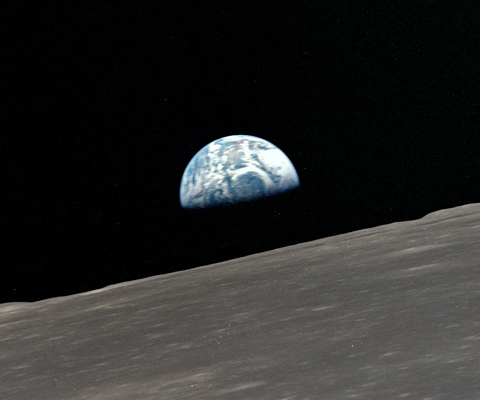
Edited Apollo 10 image of the Earth as seen from lunar orbit. (Credit: Stuart Rankin via Flickr)
Like any year, 2015 had its share of good and bad, tragedy and beauty, hope and despair. It's difficult not to get discouraged by events like the Syrian war and refugee crisis, violent outbreaks in Beirut, Paris, Burundi, the U.S. and so many other places, and the ongoing climate catastrophe.
But responses to these tragedies and disasters offer hope. It became clear during 2015 that when those who believe in protecting people and the planet, treating each other with fairness, respect and kindness and seeking solutions stand up, speak out and act for what is right and just, we will be heard.
As Syria descended deeper into chaos during 2015, people in many wealthy nations called for blocking refugees. But many more opened their hearts, homes and wallets and showed compassion. Governments responded by opening doors to people who have lost everything, including family and friends, to flee death and destruction.
Shootings and the inevitable absurd arguments against gun control continued south of the border, but many people, including the president, rallied for an end to the insanity. And while the U.S. presidential race remains mired in bigotry, ignorance and a dumbfounding rejection of climate science, many U.S. citizens, including political candidates, are speaking out for a positive approach more aligned with America's professed values. And in 2015, voters here and elsewhere rejected fear-based election campaigns that promoted continued reliance on climate-altering coal, oil and gas.
The fossil fuel industry and its supporters continued to sow doubt and confusion about the overwhelming evidence for human-caused climate change and to rail against solutions, but many more people marched, signed petitions, sent letters, talked to friends and family, demanded action from political, religious and business leaders, and got on with innovating and implementing solutions.
The public appetite for a constructive approach to global warming led Canada to shift course in 2015, taking global warming seriously enough to make positive contributions at the Paris climate conference in December. The resulting agreement won't lower emissions enough to prevent catastrophic warming, but it's a significant leap from previous attempts, and it includes commitments to improve targets.
If we want to heal this world we have so badly damaged, we must do all we can. Although many necessary and profound changes must come from governments, industry and other institutions, we can all do our part. For the climate, we can conserve energy, eat less meat, drive less, improve energy efficiency in our homes and businesses and continue to stand up and speak out.
Those who fear and reject change have always been and always will be with us. They've argued ending slavery would destroy the economy; they've claimed putting people on the moon would be impossible; they've rejected ending South Africa's apartheid system; they've said the Berlin wall wouldn't come down.
With today's technological and communications advances, everyone with access to the Internet can be heard. That's good, but people who fear they have something to lose often speak loudest, and in the greatest numbers. I tell people at the David Suzuki Foundation, "Don't read the comments!" It's often disheartening to see online discourse sink to such irrational and often idiotic depths.
But many comments and efforts to stall or block necessary progress arise from fear. People who are afraid that change might remove or diminish their privilege -- real or imagined -- often do or say anything to block it. Unfortunately, those who benefit most from privilege or the status quo, even if only in the short term, often stoke those fears and uncertainties, taking advantage of and manipulating the frightened and ignorant for political or economic gain.
That's not to say people must always agree. But racism, sexism, homophobia, religious prejudice, the denial of climate science and solutions, and blindness to the need for gun control are all irrational.
We can and must speak louder than those who would keep us on a destructive path despite the overwhelming evidence that it's past time to shift course. Events in 2015 taught us that when those of us who care about humanity and the planet's future stand up and speak out, we can make this small, blue world and its miraculous life and natural systems a better place for all.
Hey! Want more DSF? Join David Suzuki on Facebook

December 27, 2015
How to plant seeds of change
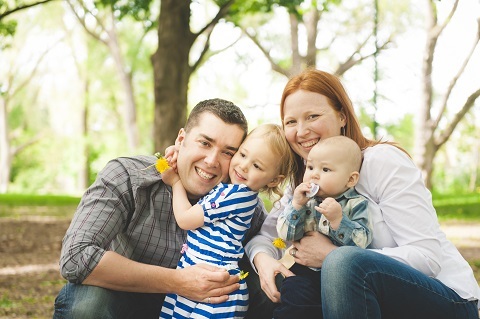
"I am feeling empowered, rejuvenated, and more confident to talk about environmental issues with others." Coach Emma (Credit: After an Afternoon Photography)
"Ours is not the task of fixing the entire world all at once, but stretching out to mend the part of the world that is within our reach. Any small, calm thing that one soul can do to help another soul, to assist some portion of this poor suffering world, will help immensely." Clarissa Pinkola Estes
This fall, my seventh round of Queen of Green Coaches bravely chose to counter feelings of being overwhelmed and impulses to withdraw with commitments to step forward and act. Each recruited five families to "green"!
Veteran Coach Ali, Chilliwack B.C. (@alilovesbugs) loves bugs, is passionate about people and lives in the forest with her partner and two cats.
Stay-at-home mom Becky, Ladysmith B.C. is "fumbling" her way towards a zero-waste lifestyle!
Blair, Saskatoon Sask. (@blairvmiller) caught the "green bug" early and encourages her family and friends to recycle, compost and ditch toxic chemicals.
Catherine F., Victoria B.C. (@Wilde_Cam) is driven to reduce her consumption by the interconnectedness between people and the environment.
Nature advocate Daniele, Nelson B.C is a mom to four kids and constantly seeks new ways to tread lightly on the planet.
Environmental engineer Emma, Toronto Ont. (@green_at_home) is a mom to two young kids and shares ways to live green and healthy on her Green at Home blog.
Eyecandypopper, London Ont. (@Eyecandypopper) is passionate about green living and healthy eating, and encourages others through her blog.
Janell, Long Creek P.E.I. has a passion for animals, the environment and all sustainable living paths.
Veteran Coach Julia, City of Kawartha Lakes Ont. (@sogreenithurts) is a green living blogger and stay-at-home mom committed to protecting her local lakes.
Nurse, mother, wife, yogi and Beaver Leader Kate, Ladysmith B.C. (@PineConeYoga) is greening a local mom-and-baby group.
Occupational therapist and educator Katie, Vancouver B.C. (@MKatieBunting) believes in the interconnectedness of all life and protecting Earth's diversity.
Mother, librarian, children's art studio owner, veteran Coach and first Queen of Green Leader Kelly, Maple Ridge B.C. (@kellyerinwoods) is mentoring four new Queen of Green Coaches, blogs about green living and dreams of building her own cob home.
Returning Coach Kimberley S., Prince George B.C. has a BA in Kinesiology and a green thumb, loves to DIY (cosmetics to crocheting) and enjoys the challenges of being eco-friendly and bringing others along for the ride.
Lori, Coquitlam B.C. is a retired teacher, new grandma, nature lover and co-author of a free children's nature guide who is committed to better lifestyle choices for the health of humans and the planet.
Agrologist Lynne, Melfort Sask. (@crwatershed) is a mother of four and watershed manager with the Carrot River Valley Watershed Association.
Michele G., Nanaimo B.C. is working on her master's degree in Sustainable Leisure Management and is passionate about the three pillars of sustainability.
Michele R., Kelowna B.C. has been a fan of David Suzuki from age six, became vegan at 16 and raised her two children as vegetarians.
Marketing manager for Winnipeg's largest law firm, Nicola, Winnipeg Man. (@dempseynicola) has been driven to increase and share ecofriendly choices since becoming a new mom.
Nicole, Lethbridge Alta. is a registered nurse working in public health, currently on maternity leave with her baby girl.
DSF volunteer since 2010 and one of the first four Queen of Green Coaches, Norma, Surrey B.C. is currently working on a master's degree in Environment and Management and serves on the City of Surrey's Environmental Sustainability Advisory Committee.
Mom, marketer and nutritionist-in-training Roanne, Maple Ridge B.C. is passionate about eating whole, organic foods, sustainable farming and food security, and limiting exposure to toxins.
Lifestyle coach Sandra, Toronto, Ont. lives in the heart of the city with her Russian Bolonka pup and conscientiously contributes to a sustainable future.
Shannon, Cold Stream B.C. who works from her home surrounded by forest and lakes and believes there is much to learn and many to inspire, especially children.
Project co-ordinator turned entrepreneur Tracey, Sackville N.B. enjoys living on the New Brunswick-Nova Scotia border, loves a challenge and believes in a minimal, eco-friendly life.
Valerie, North Vancouver B.C. is passionate about nature, gardening, healthy eating, helping others and protecting Mother Earth, and wants to inspire people to do the same.
You don't need to be an "official" Queen of Green Coach to lead. What are you doing in your community?
Sincerely,
Lindsay Coulter, a fellow Queen of Green
Hey! Want more DSF? Join David Suzuki on Facebook

December 21, 2015
How to plant your Christmas tree

A live tree will only last inside for a week to 10 days. (Credit: Lindsay Coulter)
One day I'll plant a Christmas tree.
Until then, I'll keep decorating my trusty Norfolk Island pine that gives my family the gift of clean air all year round.
But if you have the space, you can start your Christmas tree forest this season. NOTE: Try this if you plan to keep your live tree inside only for a week to 10 days AND you're diligent at watering plants.
Four reasons most replanted holiday trees don't survive or thrive:
The tree species isn't adapted to the local climate (moisture, elevation, etc.)
Tree size -- big trees suffer more transplant shock
Tree thirst -- while inside, it dried out too many times
Trees on display inside too long lose winter hardiness
Prepare your tree for indoor festivities AND a life outside!
What should I look for in a tree?
Fir, pine and spruce are best (ask your local nursery)
Long, full branches
A large root ball that's not frozen
How do I get the tree ready for indoor life?
To reduce the shock of the warm house, a few days before bringing the tree inside leave it in a cool, slightly damp area (garage, shed or basement). Keep the root ball covered with straw, peat moss or an old blanket. Water often -- even add ice cubes!
What do I use for a tree stand?
Choose a container that accommodates the root ball, then pack with sawdust, peat moss or shredded newspaper. Drape a cloth over the root ball to keep moisture in.
Place the tree near a window away from heat -- vents, electric baseboards, fireplaces, and woodstoves.
How do I transition my indoor tree for planting outside?
Keep the tree outside -- exposed to minimal sunlight and winter wind
Pack paper bags of leaves or straw bales tightly around the root ball
Periodically add snow to the root ball to prevent drying out
When the soil isn't completely frozen...
Dig a hole about one-and-a-half times larger than the root ball. Store the dirt in the garage (so it doesn't freeze) until planting day.
Gently re-introduce the tree to the cold for a week or two before planting. Keep it out of the wind, maybe in the garage.
Remove root ball coverings (e.g., burlap).
On a mild day, place the tree in the hole and backfill. Cover the hole with several inches of mulch and water. NOTE: To prevent suffocation, don't plant the tree deeper than it was in the nursery pot. The top of the root ball should be one to two inches above ground level.
What about fertilizer?
Do not fertilize live Christmas trees in winter. They're dormant. Fertilize in the spring.
Do I need to stake the tree?
Yes. Stake to support it from strong winds so it can establish roots.
Have you ever planted a Christmas tree?
Sincerely,
Lindsay Coulter, a fellow Queen of Green
Hey! Want more DSF? Join David Suzuki on Facebook

December 17, 2015
Paris Agreement marks a global shift for climate
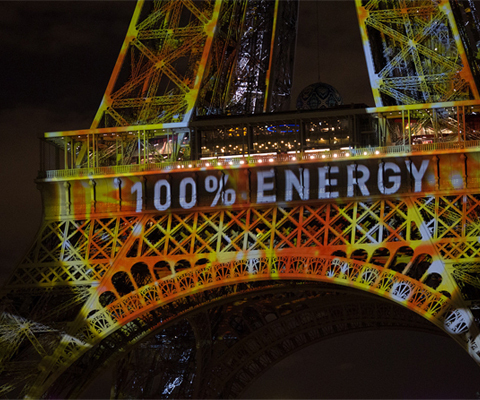
(Credit: Mark Dixon via Flickr)
When our children's children look back to what we did to keep our planet livable, they may see this year's United Nations climate conference in Paris as a turning point.
The 21st Conference of the Parties (COP21) may have been our last chance for a meaningful agreement to shift from fossil fuels to renewable energy before ongoing damage to the world's climate becomes irreversible and devastating. Government ministers, negotiators and world leaders spent the first two weeks of December creating a guide for the next stage of humanity's action on climate change.
Nations that met in Paris are responsible for over 95 per cent of global emissions. On December 12, following multiple rounds of long meetings, they revealed the final text of the Paris Agreement.
Though far from perfect, it's a significant achievement. When nations last attempted a global climate pact -- in 2009 at COP15 in Copenhagen, Denmark -- negotiations broke down and the resulting declaration was considered a failure. The Paris Agreement, in process and outcome, is a dramatic improvement -- a product of the growing urgency to act on the defining issue of our time. It's the first universal accord to spell out ways to confront climate change, with Canada and other industrialized nations required to transition from fossil fuels to 100 per cent renewable energy by 2050 and developing nations by about 2080.
Before meeting in Paris, governments drafted plans to reduce national carbon emissions beginning in 2020. One COP21 negotiation goal -- a review mechanism to encourage countries to improve targets over time -- was achieved, giving hope that reductions will keep global temperature rise below the 2 C limit beyond which science indicates the consequences of burning fossil fuels will become catastrophic. Present commitments won't quite get us there, but the called-for improving of targets every five years will get us closer. Past experience shows that once a commitment is made to address a crisis, many unexpected opportunities and solutions result. The agreement also acknowledges that limiting temperature rise to 1.5 C should drive future goal-setting.
Canada's delegation had the added goal of rebuilding the country's reputation as an environmental leader. For years, we received countless "Fossil of the Day" awards for short-sightedness and stonewalling negotiations.
Responding to calls from citizens countrywide, our delegation returned to a more co-operative approach, advocating for inclusion of human rights and indigenous knowledge, along with recognition of the critical importance of the 1.5 C goal. Canada still received two "Fossil" awards, for lacking emissions-goals ambition and limiting availability of funds for "loss and damage", but compared to some nations, our country was a positive force.
The world's largest greenhouse gas emitter, China, was criticized for trying to water down requirements for a common emissions-and-targets reporting system and opposing a process to require countries to update emissions-reductions goals every five years, advocating instead for voluntary updates.
Compromises produced a final product that falls short of assigning liability for past emissions and providing dependable "loss and damage" payments to nations already suffering from the effects of climate change. Ongoing pressure is also needed to ensure targets are met and become more ambitious over time. Despite these shortcomings, the Paris Agreement is a leap forward in the fight against climate change. Funding for vulnerable and developing nations, plans to ratchet up ambition at regular intervals and recognition of the role of indigenous knowledge will play major roles in future action.
The first step in realizing stronger goals for Canada begins now. Our government promised more ambitious targets and a framework for cutting carbon pollution and expanding renewable energy within 90 days of the conference, by March 11, 2016. We've learned Canadian leaders will stand up for important issues, but we need to push them to be as ambitious as possible. I believe Canada's commitment will inspire people at all levels of society to propose ways to speed up our shift to clean, renewable energy, and reduce waste through greater energy efficiency.
The global community has taken a big step to get human civilization back on track. It's up to us to ensure that the planet we want -- with clean air, safe water, fertile soil and a stable climate -- stays within reach, for our sake and the sake of our descendants.
Hey! Want more DSF? Join David Suzuki on Facebook

December 16, 2015
China's climate commitment

Credit: Credit: kyo628 via Flickr
Reactions around the world to the Paris UN climate agreement last week ranged from cheers to comments decrying the focus on promises and lack of action. The same can be said about reactions to China's commitment to the Paris Agreement.
China is the highest carbon emitter -- producing 11 billion tons in 2013, almost double U.S. emissions -- so a more aggressive emissions target is essential to keep global temperature rise below the 2 C limit.
Just six years ago in Copenhagen, the summit collapsed in acrimony and was deemed a failure. The Paris Agreement, on the other hand, demonstrated compromise and co-operation. China was encouraged to take action to address mounting pressure at home to deal with extreme weather, droughts, flooding, crop losses and air quality advisories.
Those applauding the Paris Agreement point to the six nations, including China, that produce 60 per cent of the world's carbon emissions committing to report their plans and results every five years starting in 2020. Skeptics don't believe high-emitting nations such as China will actually follow through.
News reports from China, however, give hope. China's Central Government news agency reports that the commitment to cut carbon emissions per unit of GDP by 60 to 65 per cent from 2005 levels by 2030 and require carbon emissions to peak by the same year is significant. Renewable energy consumption will increase to about 20 per cent over the same period. For the first time, Chinese leaders acknowledge they need to do better for their people and their country's stability.
"China is quite self-motivated when it comes to fighting climate change," Xinhua reported. "With a large population, China is facing increasing resource constraints, severe environmental pollution and a deteriorating ecosystem, and its citizens are also becoming increasingly aware of environmental problems."
It may take years for vast, diverse China to plan for change and get buy in at all levels. Local governments bearing the brunt of climate change effects need the national government's assurance that a cleaner energy future won't create unbearable pain.
In an interview on CBC Radio's "The Current", academic Tao Wang said, "China has gone through three decades of fast growth mostly from heavy industrialization, producing for China and developed nations. For China to peak emission in the next 15 years is very aggressive."
China's road to a new climate future under the Paris Agreement will be challenging. But India, Japan, South Korea, the U.S., Russia and Canada also face significant challenges.
China is responding to internal and global pressure, which led to the China-U.S. agreement before the Paris summit. California has been advising on climate strategy, especially cap-and-trade approaches, which China has committed to begin in 2017.
We can either refuse to accept that change is possible or we can each do our part to build a cleaner world. Canada can help China reach its commitments by being a friend and mentor -- two roles we've played well in the past.
Hey! Want more DSF? Join David Suzuki on Facebook

December 15, 2015
Tell Christy Clark to keep her promise to protect the Great Bear Sea
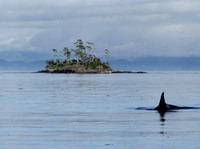
After all the hard work to protect the Great Bear Sea, it could be cut from the 2016 B.C. budget! Will you help?
Hey! Want more DSF? Join David Suzuki on Facebook

How to gift wrap (without gift wrap)

If you can tie a square knot, you can wrap gifts using furoshiki. (Credit: Weekend Knitter via Flickr)
No matter what you're giving -- "presence" or "presents" -- you can present either without ever buying another roll of wrapping paper!
Reuse fabric
It's easier than you think to wrap gifts using traditional Japanese techniques and fabrics known as furoshiki. Whether you're giving a bottle (or two) of organic wine or a tin of treats, you won't need scissors or tape.
If you can tie a knot, you can wrap using furoshiki -- they even become reusable gifts! Make your own or reuse or regift tea towels, linens, cloth napkins and scarves, or find these and other fabrics at the thrift store. Follow step-by-step folding tutorials online.
For example: Use a silk scarf from a thrift store to wrap a journal you're regifting and personalize it by writing a quote or Grandma's recipe inside.
If you get addicted to wrapping with fabric, source a large bolt of cloth and decorate it with fabric paint. The cloth art you create can be reused year after year.
Reuse paper
Get the kids in your house to make wrapping with paper found around the house (including paper grocery bags) or in your office copy room recycling bin. Then unleash the stamps, markers and paints.
Gifts in cardboard boxes are already wrapped -- kids can add personal touches directly on the boxes! And don't forget to decorate envelopes if you're giving gifts of time like tickets to a light festival or babysitting.
Resuse glass
Glass jars are the perfect vessel for homemade gifts -- from holiday mulling spices and preserves to homemade play dough and bath salts or melts.
Make your own gift tags from old holiday cards or make your own paper!
How do you add personal flare to wrapped gifts?
Sincerely,
Lindsay Coulter, a fellow Queen of Green
Hey! Want more DSF? Join David Suzuki on Facebook

David Suzuki's Blog
- David Suzuki's profile
- 247 followers



